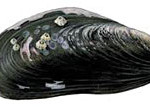
Pleuronectes platessa
The European Plaice (Pleuronectes platessa) is a member of the order of Pleuronectiformes (flatfish), which also includes soles and other flounders.
It is generally recognised as the most important flatfish for commercial fisheries in Europe. Widely distributed in the Northeast Atlantic, it can be found from Greenland and Norway in the North to Morocco in the south, in temperate waters ranging from 2 – 15°C, with the Wadden Sea being reported as an excellent nursery area.
This species lives on mixed bottoms, tending to go deeper as it ages, with smaller individuals being encountered on bathing beaches. It is active at night, in shallow water, feeding on thin-shelled mollusks and polychaetes (marine worms), spending the day buried in the sand. It is one of the commonest flatfish encountered by divers and snorkellers.
Adult fish are not bilaterally symmetrical, as one eye migrates to the other side of the head, allowing the fish to see whilst partially hidden in the sand. They can grow to a maximum size of 100 cm, but is usually between 50-60cm in length. It is diamond-shaped in outline and both eyes are on the right hand side of the body the upper side, Colouring is brown or greenish brown with irregularly distributed bright red or orange spots. The underside is white and there is a bony ridge behind the eyes and although it can change colour to match that of the surrounding seabed, the orange spots are always distinct. The scales are smooth, unlike those of a flounder, which are rough.








Social Profiles